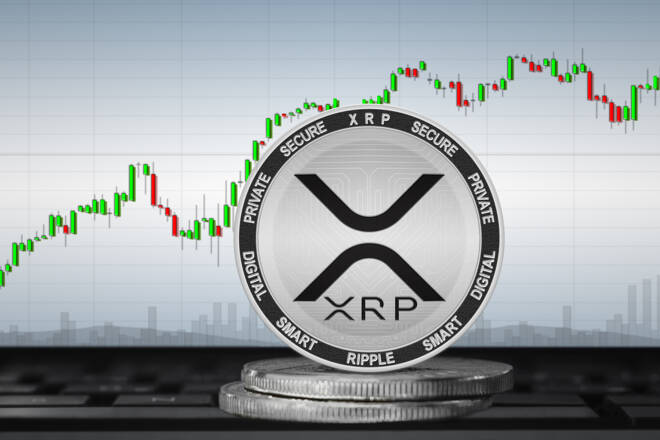Advertisement
Advertisement
XRP News: Ripple Targets Pro-Crypto US Presidential Candidates
By:
Senator Elizabeth Warren and her anti-crypto campaign have placed a greater significance on the outcome to the US Presidential Election.
Key Insights:
- XRP declined by 1.13% on Tuesday, ending the session at $0.6050.
- Ripple joins crypto firms to support pro-crypto candidates in the US Presidential Election.
- US regulatory activity and lawmaker scrutiny remain focal points.
The Tuesday Overview
On Tuesday, XRP declined by 1.13%. After a 0.38% gain on Monday, XRP ended the day at $0.6050. Significantly, XRP visited sub-$0.60 for the second consecutive session.
Ripple to Support Pro-Crypto Candidates in the 2024 US Election
On Monday, Ripple CEO Brad Garlinghouse announced support for pro-crypto candidates in the US election. The Ripple CEO had this to say,
“Team Ripple is putting a stake in the ground, leading the charge with other industry leaders to support pro-innovation and pro-crypto candidates in the 2024 US election cycle. The US cannot afford to continue taking a back seat on the global stage.”
Garlinghouse highlighted the US regulatory landscape, adding,
“Regulatory overreach (esp. from the SEC) is actively moving the US in the wrong direction, and other countries are taking full advantage of the lack of US leadership. We need to advance leaders who will champion innovation and spearhead paths towards responsible regulation.”
Garlinghouse wrapped up, saying,
“2024 is the time to go back to first principles by encouraging initiatives to promote transparency, innovation, and a compliance-first approach. Team Ripple and I won’t squander it.”
Garlinghouse shared a Politico article titled “Crypto Titans launch 2024 election play with $78M super PAC spend.”
Other early donors include Circle, Kraken, Paradigm, and Coinbase (COIN) CEO Brian Armstrong.
The outcome of the 2024 Presidential Election could significantly affect the future of the US digital asset space. Senator Elizabeth Warren’s anti-crypto campaign highlights the future under Democratic Party clean sweep victory.
Two Parties, Two Crypto Bills, and Two Possible Outcomes
The timing of the Politico article is poignant. On Monday, we considered the implications of a Democratic or Republican Party clean sweep. A clean sweep would mean one Party has control of the House and the Senate. Control of the House and the Senate facilitates the passage of bills through Congress.
Two crypto bills highlight the opposing Party attitudes toward the US digital asset space.
In 2022, Senators Cynthia Lummis and Kirsten Gillibrand filed the Responsible Financial Innovation Act in 2022. The bipartisan bill would address the SEC’s overreach by giving the CFTC statutory authority to regulate cryptos. The Lummis and Gillibrand bill aims to drive innovation while protecting US investors.
Senator Warren’s Digital Asset Anti-Money Laundering Act aims to place digital assets into the securities basket by imposing banking-style regulations. Regulations include anti-money laundering (AML) and countering the financing of terrorism (CFT) frameworks.
While frameworks addressing AML and CFT issues are necessary, punitive requirements and SEC oversight could materially impact the US digital asset space. The contrasting bills could dictate the evolution of the US digital asset space. Senator Warren’s anti-crypto stance and a Democratic Party clean sweep would be an ominous combination for crypto advocates.
XRP Price Action
Daily Chart
XRP sat below the 50-day EMA while holding above the 200-day EMA, sending bearish near-term but bullish longer-term price signals.
An XRP break above the 50-day EMA would support a run at the $0.6354 resistance level.
SEC activity, US lawmaker scrutiny, and SEC v Crypto news are focal points for the session.
However, a fall through the $0.5835 support level would bring the 200-day EMA into view.
The 14-day RSI reading, 43.07, suggests a fall through the $0.5835 support level before entering oversold territory.
4-Hourly Chart
On the 4-hourly, XRP hovered below the 50-day and 200-day EMAs, reaffirming bearish near-term price signals.
An XRP break above the EMAs would support a move to the $0.6354 resistance level.
However, an XRP fall through the $0.60 handle would bring the $0.5835 support level into play.
The 4-hourly RSI, with a reading of 42.64, suggests an XRP fall below the $0.5835 support level before entering oversold territory.
About the Author
Bob Masonauthor
With over 28 years of experience in the financial industry, Bob has worked with various global rating agencies and multinational banks. Currently he is covering currencies, commodities, alternative asset classes and global equities, focusing mostly on European and Asian markets.
Did you find this article useful?
Latest news and analysis
Advertisement
